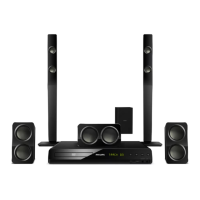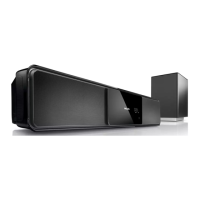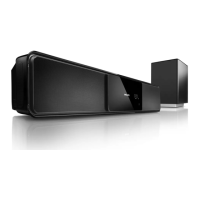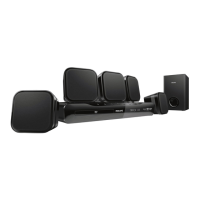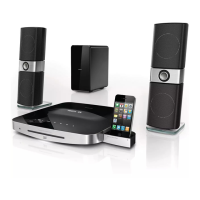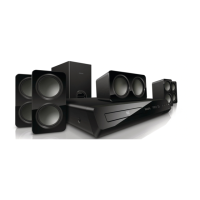
Do you have a question about the Philips HTS3531/12 and is the answer not in the manual?
| Type | Home Cinema System |
|---|---|
| Audio output channels | 5.1 channels |
| RMS rated power | 300 W |
| DVD player included | Yes |
| Audio formats supported | MP3, WMA |
| Image formats supported | JPEG |
| HDMI ports quantity | 1 |
| USB port | Yes |
| Component video (YPbPr/YCbCr) out | Yes |
| Composite video out | Yes |
| Bluetooth | No |
| Supported disc types | DVD, CD, VCD |
| Video formats supported | MPEG1, MPEG2, MPEG4 |
| Connectivity | HDMI, USB |
Legal notices, product compliance, and listed trademarks.
Specific instructions for replacing the mains fuse in UK plugs.
Essential warnings for preventing electric shock, fire, injury, and overheating.
Guidance on product care and responsible environmental disposal methods.
Description of the home theater's main unit buttons and display panel.
Details on buttons for playback, menu navigation, volume, and source selection.
Explanation of buttons like Mute, SOUND, ANGLE, and Numeric keys.
Optimal placement guidelines for front, center, rear speakers and subwoofer.
Steps to set up speakers using the home theater's setup menu.
Information on connecting devices via USB and Music i-Link ports.
Instructions for connecting via HDMI for superior video and audio.
Steps for connecting via composite video for standard quality display.
Steps to connect audio via an optical cable for best quality transmission.
Steps to connect audio via analog cables for basic audio transmission.
How to choose ideal sound modes for movies, music, and gaming.
Description of surround sound options for immersive audio experiences.
Basic steps for playing discs and using playback control buttons.
Managing menus and display options for VCD, SVCD, MP3, and JPEG files.
Procedures to adjust audio delay for perfect sync with video.
Requirements and steps for playing media files from USB storage.
Instructions for playing DivX videos from discs or USB devices.
Guide to DivX VOD registration and subtitle language selection.
Options for title, chapter, track, audio, subtitle, angle, and time skip.
How to view picture slideshows and create musical slideshows.
Instructions for tuning, listening to, and storing FM radio stations.
Steps to tune to and listen to FM radio stations.
How to connect an MP3 player and play music files.
Guide to converting audio CDs into MP3 format.
Configure speed, bitrate, device, and tracks for MP3 conversion.
Controlling home theater and HDMI-CEC devices with one remote.
Features for automatic device switching for playback and standby.
Adjust picture resolution, HD JPEG, TV system, display format, and brightness.
Configure sound preferences, including HDMI audio output to TV.
Select languages for home menu, disc audio, and subtitles.
Choose the menu language for playing discs.
Configure password and age ratings for restricted disc playback.
Methods to manually lock discs for restricted access.
Set auto standby, sleep timer, screen saver, and display dimming.
Instructions to restore the home theater to its original factory settings.
Steps to verify the home theater's installed software version.
Detailed instructions for updating software using external media.
Technical details covering amplifier power, video output, and audio inputs.
Specifications for radio tuning, USB compatibility, and main unit power supply.
Solutions for non-responsive buttons, no picture, and HDMI connection faults.
Troubleshooting steps for discs not playing high-definition video content.
Steps to fix no audio output and audio/video synchronization issues.
Solutions for disc, DivX file, and subtitle display playback errors.
Troubleshooting USB device read errors and EasyLink connectivity problems.
